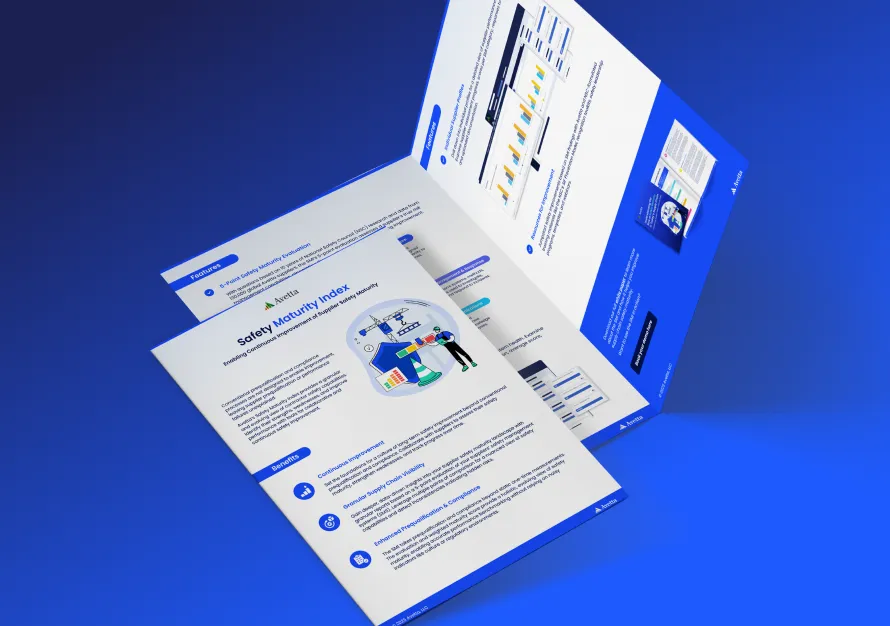Key Takeaways:
- OSHA's 2024 top 10 violations list remains largely unchanged from previous years, with issues like fall protection, hazard communication, and machine guarding consistently showing up.
- While traditional contractor prequalification and compliance programs have reduced minor injuries, they have done little to address serious injuries and fatalities, as they focus on meeting minimum safety requirements rather than ensuring effective safety systems.
- Avetta's Safety Maturity Index (SMI) offers a more comprehensive approach, assessing contractors' safety management systems and encouraging continual improvement through a Plan-Do-Check-Act framework.
- Trials of the SMI revealed that many contractors considered "compliant" under traditional metrics had poor safety practices, while some "non-compliant" contractors demonstrated strong safety systems, proving that compliance alone is not a reliable indicator of future safety performance.

Introduction
Every year, the Occupational Safety and Health Administration (OSHA) releases its top 10 list of the most frequently cited workplace safety violations. These citations offer critical insights into where safety measures fall short in workplaces across the United States. Despite advances in technology and safety programs, OSHA's top 10 citation list has remained virtually unchanged for years, reflecting deeper systemic challenges related to workplace safety.
In this post, we’ll examine these workplace safety challenges related to contract workers and introduce a new strategy for proactive safety improvement.
2024 OSHA Top 10 Violations List
Below is the list of OSHA’s top 10 safety violations between Oct. 1, 2023, and Sept. 5, 2024. Looking back on past lists, it’s clear that the same issues have been consistently problematic for decades.
- Fall Protection (General Requirements) – 6,307 violations
- Hazard Communication – 2,888 violations
- Ladder Safety – 2,573 violations
- Respiratory Protection – 2,859 violations
- Lockout/Tagout – 2,443 violations
- Powered Industrial Trucks – 2,248 violations
- Fall Protection (Training Requirements) – 2,050 violations
- Scaffolding – 1,873 violations
- PPE (Eye and Face Protection) – 1,814 violations
- Machine Guarding - 1,541 violations
Stuck in the Era of Compliance
The enduring presence of these violations suggests that many organizations remain stuck in a compliance-driven safety model, particularly when it comes to contract workers. Rather than focusing on preventing incidents before they occur, organizations are primarily concerned with meeting minimum regulatory standards. While the importance of due-diligence and traditional methods of evaluating contractor compliance remains, a better future includes no-longer screening contractors based merely on past violations or metrics like total recordable incident rate (TRIR) without assessing the actual quality of their safety management systems.
Supplier prequalification continues to be the predominant model for supplier safety, where companies screen potential suppliers based on past safety performance and safety policies. Though this is a helpful step to identify safe suppliers, it only tells part of the story.
While compliance-focused programs can reduce minor injuries, they have done little to address serious injuries and fatalities. The absence of past injuries or the maintenance of an average TRIR is not a strong indicator as to the presence of a contractor's safety capacity. In fact, industries relying solely on these lagging safety indicators may be overlooking deeper safety issues, as many "compliant" organizations may lack the systemic safeguards necessary to prevent more significant incidents.
Organizations must transition from a narrow focus on supplier prequalification and compliance to broader safety assurance and continuous improvement models. Avetta's Safety Maturity Index (SMI) offers a framework for assessing and enhancing safety performance beyond simple compliance. It is a tool that organizations can use to evaluate suppliers’ safety management systems, helping them identify not just whether a supplier is compliant but also how mature and effective their safety practices truly are.
Introducing the Safety Maturity Index
The Safety Maturity Index, developed by Avetta in partnership with the National Safety Council (NSC) and companies like Entergy and Cargill, represents a system-based approach to safety management. It assesses the effectiveness of a contractor’s safety management system (SMS), including systems, processes, and methods across multiple categories:
- Safety leadership and structure
- Hazard identification and controls
- Worker training and competency
- Incident management and response
- Improvements and communications
Contractors are scored on a 0-100 grading scale, where an A grade represents a score between 90 and 100, and a D grade represents a score below 70.
The Safety Maturity Index is rooted in 15 years of NSC research and incorporates data from Avetta’s network of 130,000 global suppliers and 1.5 million contract workers. Safety and risk professionals from companies like Entergy and Cargill contributed to the design and testing of this index, ensuring it reflects real-world supply chain safety challenges.

The Plan-Do-Check-Act Framework in SMI Implementation
The SMI is based on the Plan-Do-Check-Act (PDCA) cycle, which fosters continuous improvement in safety practices. This system is designed not only to assess contractors but also to enable organizations to deploy better systems and safeguards, reducing serious injuries and fatalities (SIFs) over time. Notably, the SMI is not just a static measurement tool but is intended to drive continuous improvement through actionable steps.
- Plan: Clients collaborate with Avetta to define safety goals, outcomes, and identify suppliers for assessment.
- Do: Avetta enables the SMI, incorporating additional supplier requirements for prequalification and worker training programs.
- Check: Avetta provides clients with dashboards, reports, and analytics to assess the safety maturity of suppliers based on their SMI scores.
- Act: Clients use SMI data to prioritize supplier enablement programs, inform compliance decisions, and deploy NSC safety resources to enhance supplier safety maturity.
By leveraging the SMI, organizations can move beyond the traditional "red or green" compliance mindset and begin building critical system elements for better safety performance, as well as continual improvement. Compliance should be seen as the baseline, and SMI can help organizations progress from compliance to safety assurance and proactive risk management.
SMI in Action: Uncovering Critical Insights
SMI provides a new lens through which organizations can view their safety programs, offering deeper insights than traditional compliance measures. Early deployments of the SMI have shown that many suppliers, while technically compliant, did not have effective systems in place to prevent serious safety incidents. The SMI helps organizations identify these gaps and take proactive steps to close them.
In trials involving 20,000 contractors across 25 countries, Avetta compared SMI scores (A-D) to traditional compliance indicators (green for compliant, red for non-compliant). Key findings revealed that 60% of suppliers with a "green" compliance status had a C or D grade in the SMI, indicating that many “compliant” suppliers were at higher risk than expected. Conversely, some non-compliant (red) suppliers had strong safety systems, with A or B grades in the SMI.
These results underscore that standard compliance checks are insufficient to understand supplier safety risks or the likelihood of a serious accident. By integrating SMI into their supplier safety programs, organizations can prioritize relationships with suppliers that have robust safety systems and avoid those who may pose higher risks despite meeting minimum regulatory standards.
Conclusion
The persistence of OSHA’s Top 10 citation list reveals that we are still stuck in an outdated, compliance-driven era. Basic prequalification and compliance programs, while important, are not enough to drive significant reductions in serious incidents and fatalities. To truly improve workplace safety, organizations must move beyond compliance and embrace assurance and continual improvement models like Avetta’s Safety Maturity Index. By doing so, they can build safer workplaces, reduce risk, and create a proactive culture of safety maturity.
For organizations ready to move beyond compliance, Avetta’s SMI offers the tools and insights needed to transform supplier safety programs. Now is the time to make the shift, improve safety performance, and protect workers from the hazards that continue to appear on OSHA’s annual list.
Watch Our Safety Maturity Webinar!
If you would like to learn more about safety maturity and how your organization can evolve toward becoming truly transformative in your approach to safety, watch our recent webinar Breaking Barriers: Going Beyond Traditional Risk Management.
Avetta is a SaaS software company providing supply chain risk management solutions. Avetta’s platform is trusted by over 130,000 suppliers in over 120 countries. Visit Avetta.com to learn about how our new Safety Maturity Index can help you go beyond compliance and prequalification.
.svg)

.svg)
.svg)

.svg)

.svg)









